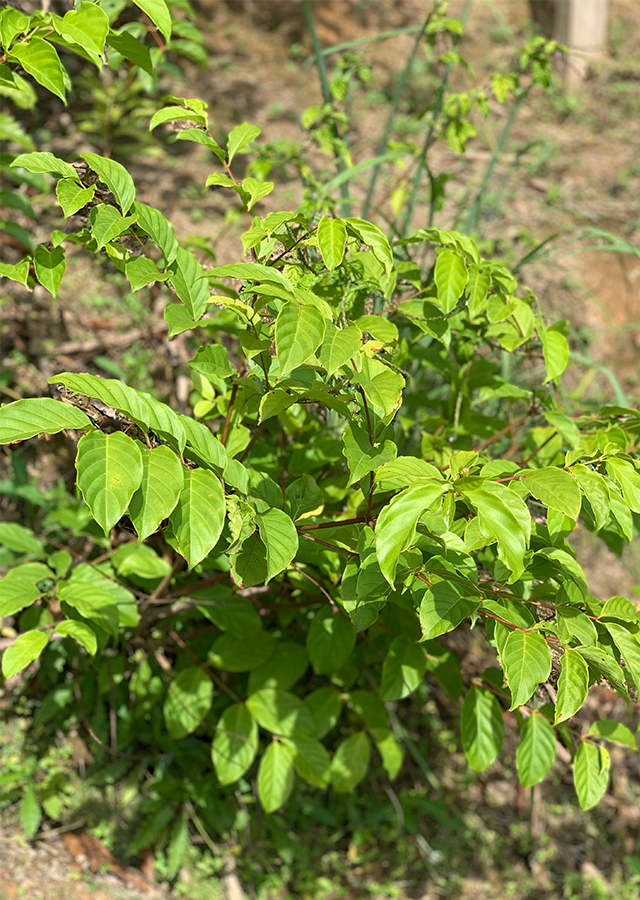Gambier
Uncaria gambir (W.Hunter) Roxb.
Rubiaceae
Location in our garden
Principal



Synonym
Cinchona kattukambar J.Koenig ex Retz.
Nauclea gambir W.Hunter
Ourouparia gambir (W.Hunter) Baill.
Habitus
Shrubs. A climbing perennial shrub that can reach 2 m tall.
Part Used
Leaves
Stem
Growing Requirements
Full Sunshine
Need Shade
Habitat
Forest
Overview
The origin of gambier is allegedly from South-East Asia, as gambier was grown in this region. It is present in Indonesia and the Malacca Peninsula in particular, but mostly in Sumatra and Kalimantan. It is harvested, mainly as a source of tannins and medicine, from the wild for local use and trade. At this time in Indonesia, West Sumatra is the hub of gambier development. Indonesia is the world's biggest gambier producer.
Vernacular Names
Gambir (Malaysia, India), Er cha gou teng (China), Asen yaku (Japan), Gambirpflanze (Germany), Gambier (France), White cutch (English).
Agroecology
This lowland wet tropics plant can be found at altitudes of up to 200 m but has been successfully cultivated up to 1,000 m. In areas within the 25-32 ° C range of daytime annual temperatures, it grows best. Average annual precipitation within the 2,200-2,400 mm range is favored. In full sun, Gambier succeeds in the shadow of light. It has no clear soil requirements, but is usually grown on soils that have a rich layer of humus, or contain a lot of clay, requiring a well-drained soil.
Morphology
- Stems - erect main stems bearing horizontal branches with recurved hooks (modified peduncles of inflorescences).
- Leaves - opposite, short-peeled, with whole margins and acute apex, from ovate-oblong to ovate-lanceolate, glabrous on both sides and 10 x 5 cm in dimension. The stipules are oblong, which unite the upper margins of the petioles' base.
- Flowers - at the middle, the peduncles are axillary, solitary jointed and braked, s. The corollas are tubular and filiform, five obtuse divisions border, vile on the outside and hairs in the center of the inside. The filaments on the tube mouth are small, the anthers are wide.
- Fruits - fruiting head 50-80 mm in diameter, 14-18 mm long fruitlets (capsules), sparsely pubescent and crowned with calyx, may be seeded, up to 20 mm long fruit stalks.
- Seeds - tiny, silvery grey, numerous, imbricated and winged, with a long wing at each end, the lower wing deeply bifid.
Cultivation
- Generative transmission occurs by seeds. The very small and light seeds easily lose their viability and so should be sown in a nursery seed-bed as soon as they are ripe.
- It takes approximately 2 weeks for the seed to germinate and can typically be transplanted into the field between 2 and 7 months after germination.
- Cuttings and layering are vegetative propagation strategies that typically lead to an advanced first harvest.
Chemical Constituents
Flavonoids (catechin), catechu tannat acid, pyrocathecol, gambir flouresensi, red catechu, quercetin, alkaloid (gambirdine), ellagic acid.
Traditional Medicinal Uses
- The most powerful use of Gambier is as an astringent, aphrodisiac and styptic.
- It is effectively used for hepatoprotection, as an anthelmintic, antioxidant, antibacterial, antifungal, liver tonic. Used as a stomach, it is also highly powerful.
- As a remedy against diarrhoea and dysentery, an infusion of fresh leaves is given. For sore throats and inflamed gums, this infusion is often used as a gargle.
- It is used externally in burn lotions and in scurf paste. Borneo has documented an external application against sciatica and lumbago.
Part Used
Reference Sources
- Fauza, Hamda.(2014). Gambier: Indonesia Leading Commodities in The Past. International Journal on Information Technology, Advanced Science Engineering, Vol.4 (6): (pp67-72).
- Fern, Ken. (2014). Useful Tropical Plants. Uncaria gambir. http://tropical.theferns.info/viewtropical.php?id=Uncaria+gambir. 27-08-2020.
- Herbpathy. (No date). Uncaria Gambir Herb Uses, Benefits, Cures, Side Effects, Nutrients Repertory.https://herbpathy.com/Uses-and-Benefits-of-Uncaria-Gambir-Cid4588. 20-11-2020.
- Ridsdale, C.E., (2016). Uncaria gambir (PROSEA) - PlantUse English. https://uses.plantnetproject.org/en/Uncaria_gambir_(PROSEA). 26-08-2020.

